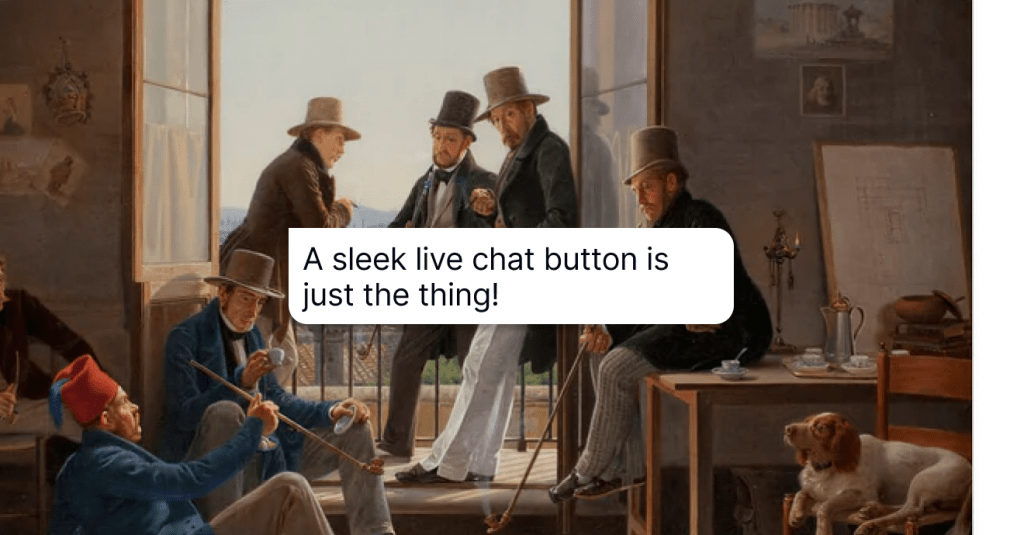15 Customer Service Scenarios for Navigating Tight Corners
Customer service scenarios are great for role plays, training newcomers, and improving skills.
Written by Anastasiia Khlystova

If you have ever been asked for a refund or had to report a feature request, you probably work in customer service or have talked to your customers once or twice. And you know the pain of answering all the same questions over and over again, don’t you?
What if I tell you those are not just the same questions but useful customer service scenarios material right there? What I mean is that you can take those typical requests, process them, and utilize them.
In this article, we’re going to talk about what such scenarios are, how to create them, and how to use them to advance your customer service. We’ll also draw a few generalized examples with pre-made answers you can save right now and leverage in your business.
What are customer service scenarios?
As your customer support team deals with all kinds of people and their various problems on a daily basis, some complex issues are quite unique and require their particular attention, while a good half of them are repeating themselves.
To not do the bad work, you have to develop a certain customer service scenario – a graphically designed script with a bunch of pre-made answers to some common clients’ questions and issues.
You can think of customer service scenario questions as a basic flowchart with a few options for how you can answer a particular request:
If you check the existing articles on the topic, you’ll see that they mostly concentrate on angry customer role-play scenarios. And while it’s important to pay particular attention to challenging situations first, there are many typical examples of good customer service situations that can make a great scenario, too.
Another question is, how exactly can those good or bad customer service scenarios help? And why would you need them?
Why do you need customer service scenarios?
Don’t be mistaken, though. Customer service scenarios are not for memorizing them. You shouldn’t know them by heart and repeat them to your clients word for word. They are more pointers that should help you quickly get a hold of the situation and move in the right direction.
Your customer service team can refer to them when they feel confused about how they should handle a particular situation.
Basically, there are two main use cases for them. First, examples of such customer service scenarios can (and should) be used to train new members of your team and upgrade their skills. Secondly, it’s a great way to prepare them for emergency situations.
Let’s now talk about each of these use cases in detail.
Customer service scenarios for training newcomers
There are several reasons why you need to think about utilizing customer service training scenarios when hiring new team members and teaching them how to operate your customer support to its maximum potential.
Even at the hiring stage, deploying your own preconceived customer service scenarios for interviews allows you to see how newcomers will approach the issues your company is dealing with daily.
Set up the scene and give your hire a minute to come up with their solution. It probably won’t be the best right away. But it will help you feel what works in their approach and what needs flashing out.
Customer service scenarios for role plays
Customer service role-playing exercises are essential for improving your team’s skill-set, as well as for onboarding new hires. Don’t feel intimidated by the word ‘role-play’, as it simply designates a training situation where an experienced team member plays the role of an angry (or otherwise disappointed) customer, and the other tries to come up with a solution.
Based on your own experience and the data your digital customer service software provides, you can create several role-play scripts that can be referred to as the ‘right’ answers.
To give you an idea, here’s a quick example of how it might look.
SETUP: Someone signed up for a one-year trial and added their credit card. They forgot to cancel before the trial ended, so they were charged a yearly subscription. Your company doesn’t have an official refund policy, but they are asking for a refund. Your move.
As a customer support operator, you have two choices in this case. Your company might not have a refund policy. So, it’s possible to refuse your customer’s requests and keep their money.
On the other hand, think about the consequences. A disappointed customer will never subscribe for real, and they might even leave a negative review for your business. What you win in several hundred bucks, you lose in word of mouth and potential customer loyalty.
But remember, you can’t be too reliant on customer service scenarios. Allow some space for your team to improvise and let them show their own personality.
SCARED CUSTOMER: Help me ASAP, my boss will kill me. I registered for your trial but forgot to cancel! I need to discuss the deal with my manager before we actually make a buying decision. Please do something.
OPERATOR: Hey! No problem. The only thing is, it might take some time, as we don’t have an official refund policy. I will get in touch with our payments platform and initiate a refund on your behalf. Don’t worry, you should get your money back in seven working days.
Customer service scenarios for emergency protocols
Customer service scenarios can be a great resource to refer to when your company faces a crisis. Everyone hopes it doesn’t happen to them, but it will. And you can prepare yourself and your team for the hard times by giving them some ready-made scenarios and response examples to rely upon.
Think about the worst situations that might happen to your business and make a list. For instance:
- Data breaches
- Server outage
- Data loss
- Crucial bug
- DDoS attack
- Payment difficulty
You can then work out some schematic angry customers scenarios where you’ll show your team how they should deal with customers’ frustration and explain everything in detail without making it worse.
SETUP: Your company has just found out you had lost some user data, including personal information like passwords. It might have become available for third parties to buy and misuse. You’ve dealt with data breaches and sent an email explaining everything to your customers. But they’re confused and scared and keep asking your team what they should do to protect themselves.
EVEN MORE SCARED CUSTOMER: Hi! I just got your email. I’m super worried that hackers will steal my identity. What should I do?
OPERATOR: Hi! First, stay calm because we’ve got you covered on that. We are very sorry for putting you through this. The situation is already taken care of. You can be sure we’ve conducted a thorough inner investigation, which showed that no credit card data or personal information beyond your password was leaked.
If you’ve changed your password, as we recommended in our email, your data is secure with us.
We value the privacy of your information and have already implemented additional security measures to prevent such breaches in the future.
Just remember, you shouldn’t panic in situations like this. While having a data breach or losing customers’ data is nothing pleasant, it happens to the best of us. Just be open and transparent about what happened while also staying calm and confident to reassure your users. Implementing robust physical security measures is crucial in preventing breaches and safeguarding businesses. By controlling access to sensitive areas, employing surveillance systems, and securing hardware infrastructure, organizations can fortify their defenses against unauthorized access and potential breaches.
15 customer service scenarios examples to get your team started
It’s obvious that no one knows your typical customer service situations better than you. No matter how many situations we might come up with, you still need to look through your experience, the data you have, and previous conversations to create your own scenarios that will be applicable to the specific niche you’re working in.
But here are a few scenarios every customer support operator will encounter at some point. Understanding how to behave in these situations means providing a better service and nurturing more loyal customers.
The best thing about these scenarios is that you can take any of the customer service response examples and use them as canned responses.
For instance, here’s how you do it in HelpCrunch. Go to Settings → ‘Saved responses’ from the main menu and press the ‘Add new’ button. After this, you just paste any example you need, and you’re good to go.

1. Customer service scenario for feature requests

EAGER CUSTOMER: Hi! I really like what you’re doing with [your product]. However, I feel like it lacks a [very specific feature that will require significant effort on your part to implement]. Do you think you’ll be adding it in the next update?
*If you can add the feature:*
OPERATOR: Hello! Thanks for letting us know. We always encourage feature requests as they help us grow and improve. Actually, you’ll be pleased to know that the feature you need is already on our roadmap for the next quarter. Our devs are hard at work building it, and they will be eager to hear what you might be looking for to prioritize their resources. I’ll let you know as soon as it’s ready.
*If you can’t add the feature: *
OPERATOR: Hello! Thank you for sharing your thoughts. The reality is that we don’t have specific plans to implement it in the near future just yet(our resources are limited!), I’ll be adding your vote to our task backlog. When the right time comes, I’ll let you know!
In the meantime, did you try [a more or less similar feature or alternative solution]? Let me know if you require help with it.
2. ‘Failed delivery’ customer service scenario

DISAPPOINTED CUSTOMER: Hi, I ordered [a specific item] from you two weeks ago, but my parcel never arrived. I want my money back!
OPERATOR: Hi! I’m sorry you didn’t receive your delivery. We can either send you another sample – that is like the one you ordered, or you can initiate a refund. Either way, we’ll be happy to assist. Please note that it usually takes 3 to 5 business days for a refund to go through.
3. Product exchange customer service scenario
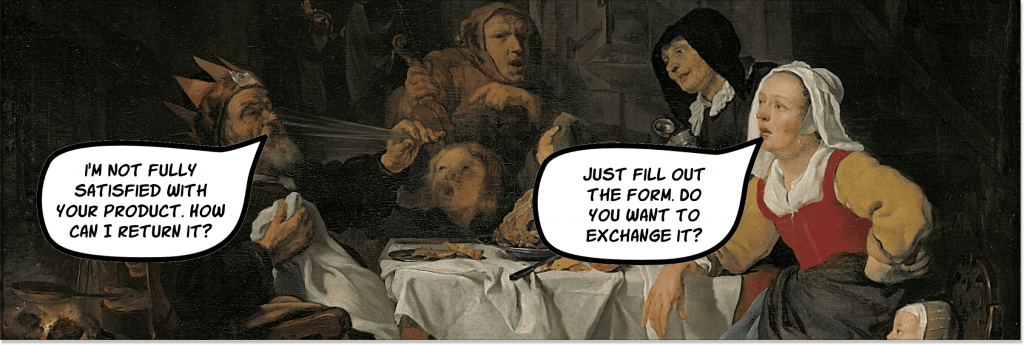
Tip: The best you can do in a situation when a customer wants to return or exchange the product they’ve already purchased is to answer as fast as possible. Their frustration and anxiety will only grow as they wait, which may quickly result in negative reviews all over the web. Answer something – anything to let them know you’re working on the issue.
UNSATISFIED CUSTOMER: Hi! I received [item 1] 2 days ago, but it turned out it doesn’t fit my needs. May I return it or exchange it for something similar?
OPERATOR: Hi! No problem, you can exchange [item 1] right away. Could you please tell us more about what you need, and we’ll pick something for you. Maybe you’ll find [item 2] or [item 3] more suitable?
UNSATISFIED CUSTOMER: [Item 2] actually looks nice. What should I do next?
OPERATOR: Great! Please send us your [item 1], and we’ll send [item 2] to you. Let me know if there’s anything else I can help you with.
4. Angry customer scenario

Tip: Well, well, well. Angry customers are everywhere. And you can’t change the fact. However, there is always a way out. The first rule is not to take everything this client says to heart. Stay calm and be persuasive in your answer.
FURIOUS CUSTOMER: I’m trying to [do something important to them] which I need for tomorrow’s presentation, and it doesn’t work!! It’s not the first, and I’ll be in real trouble if the feature doesn’t start working SOON. Assist right NOW????
*If the fault is yours:*
OPERATOR: Hi, thank you for reaching out to us. I’m already investigating the issue. It seems to me that the [reason] is the reason. I’ve already notified the dev team, and you can be sure it’s going to be fixed in [estimated period, preferably hours, if not minutes]. I’m super sorry for all the trouble—please accept this discount to make up for it.
*If the fault is on the customer’s end:*
OPERATOR: Hi, so sorry to hear that. The thing is, I’ve looked into the issue, and it seems to me that the problem might be on your end. So, let’s collaborate on that! Have you tried [a possible solution]? Let me know how it goes!
5. ‘Asking for refund’ scenarios

UNCERTAIN CUSTOMER: Hey! I bought [your product] a couple of days ago. But now I realize it isn’t what I’m actually looking for. Please refund as soon as possible.
OPERATOR: Hi! We’re sorry to hear that. Don’t worry, I’ve already made the request, so expect to see your money back by [date]. Don’t hesitate to write me back if anything goes wrong or if you have more questions. BTW, I’d really appreciate it if you tell us what went wrong — we’re always looking for an opportunity to improve.
6. ‘Why are you so expensive?’ scenario

COST-CONSCIOUS CUSTOMER: Greetings! I’m really in love with your product, but I think it’s too expensive. Are there any plans to make it cheaper? Or maybe you can offer me a discount? I’ll be happy to subscribe if not for the price.
OPERATOR: Hello! I know it can be a bit steep, but that money goes to covering the costs of our servers, paying our team, and adding new features. But did you know that we’re offering a special discount [yearly subscription discounts / wholesale purchases / upcoming holiday discounts/discounts for nonprofits, etc.]? Is it what you’re looking for?
7. ‘How are you different from competitors?’ scenario
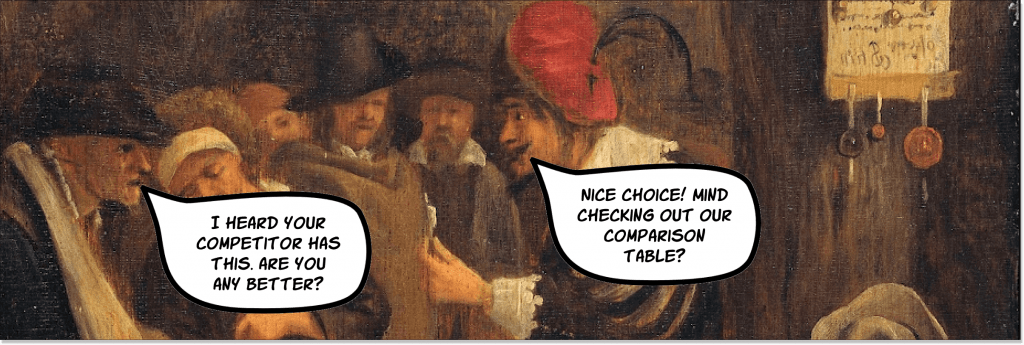
Tip: It’s useful to make a couple of comparison pages where you explain how you’re different from the competition feature by feature. Requests like these come in often enough that it’s easier to send the customers a link to a table than try to explain it anew every time — you’re bound to forget something anyway. Take a look at HelpCrunch’s own comparison page vs Intercom or vs Zendesk to get inspired.
PICKY CUSTOMER: Hi, I’m looking for [a specific product] alternative. Can you explain how you’re different from [specific product]?
OPERATOR: Hello! While [specific product] is a great solution, we actually beat them by [feature 1, feature 2, price]. Take a look at our comparison page if you want to learn more: [link]
If you still have doubts after that, I’ll be happy to schedule a demo with you and showcase the difference between our two products in action.
8. ‘Is your service down?’ scenario

Tip: This is the time when you can actually say sorry for the inconvenience. Nothing is immune to system errors, and you have to explain to a customer the reason plus express your regrets about that.
UNPLEASED CUSTOMER: Hi, I keep getting a 500 error when trying to access my profile. Is your service down?
OPERATOR: Hey there. Unfortunately, we’re indeed facing some troubles with our server provider. Our team is hard at work fixing the problem, and we should be up in [estimated period]. We’re really sorry for the inconvenience!
9. Customer service scenarios for approaching foreign customers

Tip: Sometimes people don’t know the language of your service, so they try to communicate with you in their native language. You can always ask them to switch to English (if that’s an option), but a better choice would be to use Google Translate/ChatGPT and try to communicate with the customer that way. Just make sure to mention it to them beforehand.
FOREIGN CUSTOMER: Привіт! А коли буде інтеграція з OpenAI? Вже довго чекаємо!
OPERATOR: [Hi, unfortunately, I don’t speak Ukrainian, but I’ll try to use Google Translate — hope we’ll understand each other! Sorry for the mistakes.
Hello! Thank you for reaching out. We appreciate your enthusiasm for the OpenAI integration. Rest assured, it’s currently in progress, and we’re diligently working to deliver it. We understand your anticipation and will keep you updated on the timeline. Thank you for your patience!
Google Translate/ChatGPT: Привіт! Нажаль, я не розмовляю українською, але я спробую використати Google Translate — сподіваюся, ми зможемо один одного зрозуміти! Вибачте за можливі помилки.
Вітаємо! Дякуємо за звернення. Ми цінуємо ваш ентузіазм стосовно інтеграції з OpenAI. Будьте впевнені, що цей процес вже в розробці, і ми працюємо над його впровадженням. Ми розуміємо ваше очікування і будемо вас тримати в курсі щодо термінів. Дякуємо за терпіння!
10. Customer service scenarios related to bug reports

METICULOUS CUSTOMER: Hello. I’m trying to [do a specific action], but it seems that you have a bug that prevents me from doing it. Please confirm it’s not something on my end.
OPERATOR: Hello! I’ve investigated the issue myself, and it seems that the bug is indeed happening on our side. I’ve already reported it to our dev team, so expect it to be fixed in [estimated period]. In the meantime, could [an alternative solution] help you do what you were trying to?
11. Trash talking scenarios
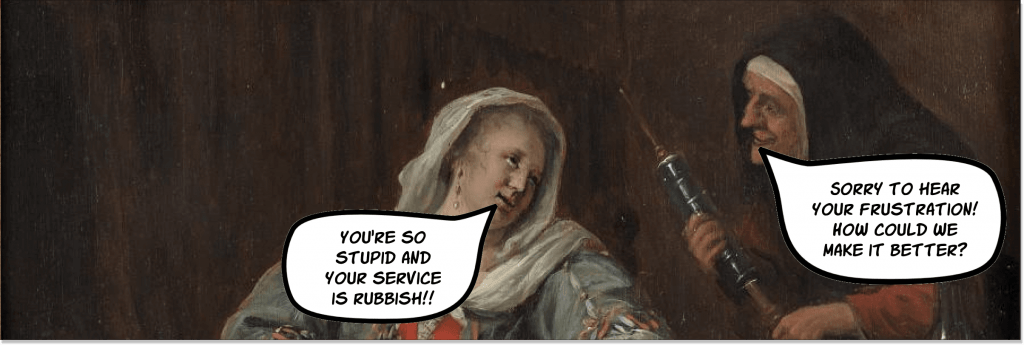
Tip: Sometimes, people just want to watch the world burn. Not every customer is going to be polite, pleasant, and understanding, so you should expect to encounter situations where nothing is clear – except that the person on the other end is very, very angry. There’s nothing you can do, though: haters gonna hate.
ANNOYING CUSTOMER: You suck, and your product sucks!!!! Go to hell!
OPERATOR: Hi, I’m sorry to hear your frustration! If there’s anything I can actually do to make you feel better, please let me know. [*optionally* sad cat GIF]
12. Transferring a call/chat scenario

Tip: Before telling a client you have to transfer a call/chat, give them reasons why this needs to be done. Otherwise, you risk ending up with a not-so-flattering review and losing a customer.
PUZZLED CUSTOMER: Hi! I have this issue with [your privacy policy/checkout/my account/etc.]. Can you please help me?
OPERATOR: Oh, I see! This might be an issue of interest for my colleague from another department. Would you mind if I transfer the call/chat to them? It won’t take even a minute, he/she will help you handle the problem ASAP.
13. You have to say “No” scenario
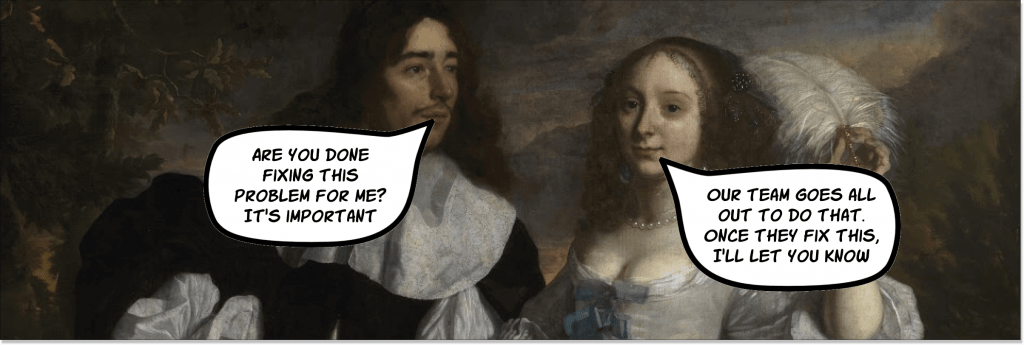
Tip: Do I have to highlight the importance of not saying NO to a client, even if you really want to? It not only pushes them off but also makes you an amateur in their eyes. So, it’s in your best interest to omit this word at any cost. And here is how you can do just that.
INTERESTED CUSTOMER: Hey there! I failed to use my second free trial, a month is not the longest period, you know. I would like to extend it. What should I do?
OPERATOR: Hello! We are so glad you keep choosing our product! It’s a pity you haven’t had the chance to test it because it’s really worth it. Unfortunately, we have no technical possibilities to extend your trial for the third time. On the bright side, here is an X% discount on this subscription plan. We would really like you to enjoy our product!
14. Asking a customer for a feedback scenario

Tip: Asking for a sincere client review is an indispensable part of your job. And there is nothing to be ashamed of. View it as yet another valuable source for the improvement of both your product and customer service.
*After the chat or call with a client is finished*
OPERATOR: It was nice talking to you, [customer’s name]. As we strive to provide the best service to you and our customers, we would really appreciate your honest feedback about your experience with our company. Could you please [follow this link/fill out this form] for us? It won’t take long. Thank you in advance!
15. Pointing a customer to an FAQ section scenario

Tip: This one might be a little tricky, but customer self-service is never revoked. Use this chance to demonstrate your FAQ page in all its glory. But remember! You should only do that when you know for sure all the answers are there, and a client won’t feel dumped.
OPERATOR: I see what you mean here. Especially for such purposes, we’ve created this in-depth FAQ page with all the necessary information. You are welcome to check it right here [link]. If you happen to not find a solution, just drop me a line, I am more than happy to assist.
Creating a positive customer experience
What outstanding benefits can a positive customer experience truly provide for your business? All kinds, to be exact, because clients are still equal money and happy customers tend to bring even more money. Loyalty encourages repeat purchases and enhances brand reputation.
To achieve this, businesses must adopt a successful customer experience strategy, which usually includes a customer-centric approach, encompassing every aspect of customer journeys.
Establish clear expectations ещ set the stage for a positive customer experience. By communicating product or service features, pricing, and delivery timelines clearly, businesses can manage customer expectations and avoid disappointments.
Identifying and analyzing customer needs
Knowing your customer needs opens a whole new world of opportunities for you. First, you can personalize interactions. Second, ensure clients get what they want. And third, figure out exactly the ways and directions of polishing your offer. This involves understanding customer demographics, preferences, and pain points through surveys, interviews, and social media monitoring.
Developing a comprehensive customer service strategy
Yes, you do need a customer service strategy to align employee actions with the company’s customer-centric goals (I hope 😉). If you ask me, it should be outlined in a customer service standards checklist, training programs, and communication protocols to ensure consistent and high-quality customer service across all channels.
Building customer relationships
To build strong customer relationships, you need to go beyond simply providing products or services. Instead, it involves promoting emotional connections by understanding individual needs, anticipating concerns, and proactively addressing issues. Leverage personalized experiences to tailor recommendations, offers, and communication.
Below you can find a few simple tips on how to build strong customer relationships:
Handling complex issues and negative experiences promptly and efficiently
Never ignore a negative review or a “too complicated issue”. Why? It’s critical for retaining customers. Businesses should establish clear escalation protocols, empower employees to make decisions, and provide ongoing training for handling angry clients.
Ensuring consistency across all customer touchpoints
Consistency is the key to customer satisfaction. From online interactions to in-person encounters, it reinforces the brand’s identity and provides a seamless customer experience. This involves using consistent messaging, design elements, and customer service standards across all channels.
Using feedback to improve performance
Customer feedback is invaluable for identifying areas of improvement and refining customer service strategies. I guess it goes without saying. Businesses should actively collect feedback through surveys, reviews, and social media interactions to gain insights into customer satisfaction levels and identify areas for enhancement.
Measuring the quality of customer service
The importance of measuring customer service quality on the whole customer journey map is hard to exaggerate. But what does it really mean? It involves establishing clear goals for customer satisfaction scores, identifying appropriate metrics to assess the success of customer interactions, and evaluating the impact of business outcomes on customer experiences.
Setting measurable goals for customer satisfaction scores
Setting goals provides a benchmark for evaluating the effectiveness of customer service efforts. These objectives should be specific, attainable, relevant, and time-bound (SMART) to ensure they are achievable and aligned with overall business goals.
Determining the right metrics to measure successful experiences
So, what metrics are important to measure? Common customer experience metrics include net promoter score (NPS), customer satisfaction score (CSAT), customer effort score (CES), and first-contact resolution (FCR) rate. These metrics will show if your users encounter a bad experience more often or a good one. Once you have all the data, you can build a customer experience strategy, addressing the areas for improvement.
Analyzing the relationship between business outcomes and customer experiences
Find out how well customer service contributes to overall business success. This analysis involves examining the impact of customer satisfaction on factors such as customer retention, revenue growth, and brand reputation. By understanding these connections, businesses can make informed decisions to optimize business performance.
Conclusions
Customer service scenarios are essential. Well, you get that already. Pre-made scripts allow you to train newcomers, improve your skill set by role-playing typical issues, and have something to refer to in uncertain situations.
If you feel like utilizing those handy scripts right away, just register for a free 14-day HelpCrunch trial and start doing just that. Quickly save any of the suggested replies as ‘saved responses’, edit them as you like, and accelerate your customer service drastically.





